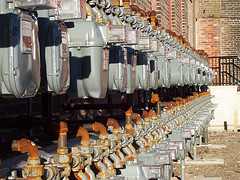 There is a certain fantasy, at least among Americans, that they might go off-grid. Grow their own vegetables, keep a some live stock, heat the house with wood from from their own wood lot, a yurt, a windmill, some solar panels. Of course a the satellite TV and Internet connection would be nice. Off grid is one thing, but no TV or Internet – that’s crazy; I mean “there are more World of Warcraft players than farmers.”
There is a certain fantasy, at least among Americans, that they might go off-grid. Grow their own vegetables, keep a some live stock, heat the house with wood from from their own wood lot, a yurt, a windmill, some solar panels. Of course a the satellite TV and Internet connection would be nice. Off grid is one thing, but no TV or Internet – that’s crazy; I mean “there are more World of Warcraft players than farmers.”
The grids fascinates me; including the utility grids.
I contemplated my gas bill (google spreadsheet, the onion). Broadly the gas bill has two parts; one part is the cost of the gas and the other part is the cost of tapping into the gas distribution network. The gas distribution network is a classic two sided network; they buy from assorted suppliers and sell to assorted consumers. Here’s the formula, a function of C and T; where C is their cost to buy the natural gas, and T, the number of therms of gas I use.
Bill(T, C) = $14.72 + .34*min(0,max(T-3,47) + .053*min(0,T-50) + (1/45+C)*T
For me $300 a year, about a quarter of the bill is the cost to access the local distribution network.
I could go half off the grid, saving $150 a year if I could coordinate my purchase with a neighbor. We agree to form a gas purchasing micro-coop. One of us cancels our service and we run a pipe over to his house from the remaining service. You can buy a gas meter so the bill is split equitably.
Schemes like this are all about coordination costs. I think you could do a lot to lower those coordination costs by providing a bit of innovative technology and IT to help. For example. Consider the micro-gas coop outlined above. A vendor might offer a kit for setting this up. The kit would include a gas meter for each member which reports usage back the vendor who then bill the members. This reduces the coop’s coordination costs to signing up, setting up, and occasional maintenance of members. Reducing an on going coordination cost to mostly just a plumbing problem.
Of course there are other utilities that this makes even more sense for. Internet access and cable TV access for example. The CATV installer, some years back, told me about some guy in a small city north of here who had his entire neighborhood running off a single CATV subscription. At least at that time the rules were such that you could do that; and even today there is plenty on the CATV cable that you can view just by plugging your TV into it.
Meanwhile, flickr has a great pool of gas meter photos. Where you can see there are plenty of apartment buildings a coop housing estates were a micro-coop wouldn’t be that hard to plumb.
Here’s an interesting snapshot http://skitch.com/bhyde/bup51 a condo development where they haven’t been able to sell any units, so all the gas meters haven’t been installed.